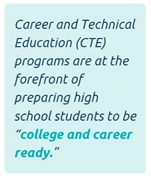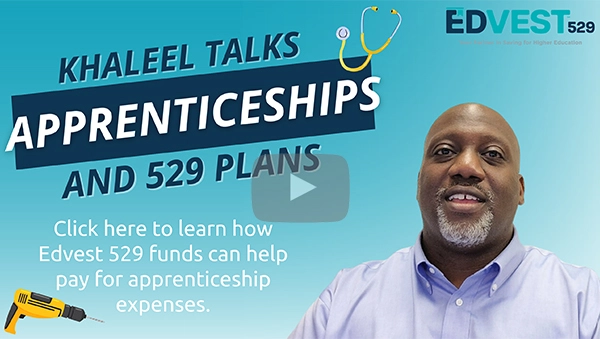Celebrating Career and Technical Education Month
By: Chelsea Wunnicke, Wisconsin Department of Financial Institutions
published February 14, 2025

February is recognized as Career and Technical Education Month in Wisconsin and across the nation. This month is dedicated to promoting the many types of Career and Technical Education (CTE) pathways that are available to students, and the positive outcomes associated with participation in these programs, both while in high school, and beyond.
According to the U.S. Department of Education, almost all high school students take at least one career and technical education course, and 25% of students take three or more courses in a single program area.1 Students who complete a rigorous academic core coupled with a career concentration, are more likely to pursue college, and are less likely to drop out in the first year. In fact, CTE concentrators (students who take two or more CTE courses in the same pathway) are 10 percent more likely to graduate than the general school population.1
What is Career and Technical Education?
Career and Technical Education (CTE) programs are at the forefront of preparing high school students to be "college and career ready."1 CTE programs offer a blend of career exploration, internships, and coursework designed to build academic, employability, and job-specific technical skills tied to defined career pathways. Learning and hands-on experience gained through CTE help students understand their post-secondary options and pursue a dream career.

Practical Experience for Students
Students enrolled in CTE areas are as diverse as the multitude of programs that are offered and include high school students getting a jump-start on post-secondary education, recent high school graduates pursuing associate degrees and technical certificates, as well as those apprenticing with local employers in Youth Apprenticeship or Registered Apprenticeship programs.
Saving for Expected Costs
While enrolled in a public high school, the costs of participating in a CTE program are generally not passed along to the family. Instead, participating in CTE programs is a way for students to get the most out of their high school experience. Students may be able to benefit from earning college credits while in high school, and some students even earn a wage for participating in workforce-based programs.
After graduation, students often continue their education at technical colleges, universities, or Registered Apprenticeship programs, where costs such as tuition, fees, and supplies arise. Families can prepare for these expenses by saving in an Edvest 529 College Savings Plan. These accounts offer tax-free withdrawals for qualified educational expenses, including tuition, books, and certain living costs. Additionally, if a student enrolls in a Registered Apprenticeship program, Edvest 529 savings can cover required tools and supplies.
Planning for the Future
Looking for ways to help a child in your life succeed in school and beyond? Here are some tips to help encourage students of all ages.
- Encourage their exploration of college and career options through school, extracurriculars, and family activities. For young children, point out different jobs in the community and the type of training needed for them. As students get older, they can explore interests and begin gaining skills and work experience.
- Talk to your children about their interests and plans for the future. What does your child love to learn and do? Help them find ways to connect these interests to potential courses of study and careers.
- Save money for their future education expenses with the Edvest 529 College Savings Plan. Edvest 529 can grow with your child and supports a wide range of educational pathways. Qualified withdrawals can cover expenses for traditional college, technical and trade schools, and even Registered Apprenticeship programs. With options like these, Edvest 529 helps families navigate the expanding paths to career success—just like those highlighted in the recent press release, Exploring the Path of Apprenticeships through an Edvest 529 College Savings Plan.
Career and Technical Education equips students with essential skills to excel in high school, advance their education, and achieve career success. By encouraging exploration, fostering meaningful conversations, and planning financially, families can help their children thrive in an ever-changing job market.
Resources for Career and Technical Education in Wisconsin
- Wisconsin Department of Instruction. Career and Technical Education Month.
- Wisconsin College Savings Program offers information about saving for higher education and can attend outreach events across the state.
Want more details on apprenticeships programs and how to use your 529 to pay for them?
Check out our "Khaleel Talks: How to use a 529 Plan for Apprenticeships" video for how you can use your 529 plan savings to pay for Registered Apprenticeship programs. Learn the basics of 529 plans, the benefits of using them for apprenticeships, and the simple steps to get started.
About Chelsea:

Chelsea Wunnicke serves as a Wisconsin College Savings Program Finance Officer with the Wisconsin Department of Financial Institutions. With a background in delivering Financial Capabilities Outreach and Education, Chelsea has a special interest in helping more Wisconsin communities and youth benefit from early saving for higher education. She lives with her family in rural Richland County, Wisconsin.
###
To learn more about Wisconsin’s Edvest 529 College Savings Plan, its investment objectives, risks, charges and expenses, see the Plan Description at Edvest.com before investing. Read it carefully. Investments in the Plan are neither insured nor guaranteed and there is the risk of investment loss. Consult your legal or tax professional for tax advice. If the funds aren't used for qualified higher education expenses, a federal 10% penalty tax on earnings (as well as federal and state income taxes) may apply. Prior to investing, check with your home state to learn if it offers tax or other benefits such as financial aid, scholarship funds, or protection from creditors for investing in its own 529 plan. TIAA-CREF Individual & Institutional Services, LLC, Member FINRA, distributor and underwriter for Wisconsin's Edvest 529 College Savings Plan.
Neither TIAA-CREF Tuition Financing, Inc., nor its affiliates, are responsible for the content found on any external website links contained herein.
4166852-0326
More to explore
-
Explore our plan
Learn more about eligibility and all the qualifying expenses an Edvest 529 account can cover.
How our 529 works -
Compare investment portfolios
We make it easy to choose investment portfolios that fit your financial needs and savings goals.
Discover your options -
Ready to get started?
Open an Account
